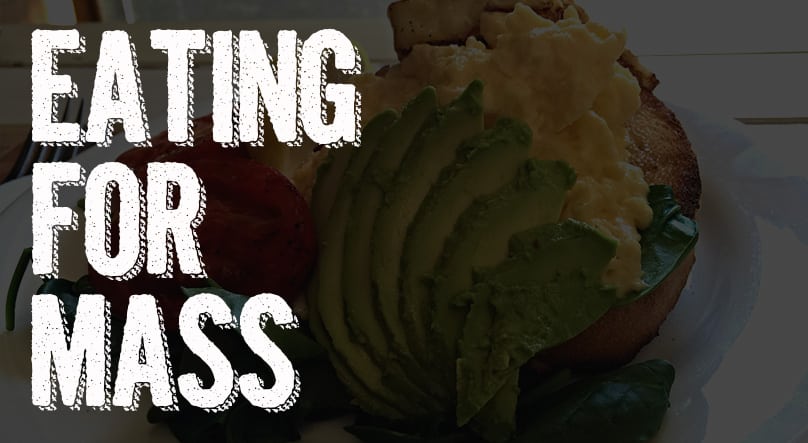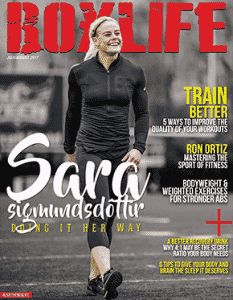For many athletes, adding mass to their bodies can equate to moving weight a lot easier in the gym—and you’ll look stronger too which doesn’t hurt. Of course, resistance training with weights will give you a solid foundation from which to build on, but to get the best results, you need to do some serious work…in the kitchen.
Eating for size
When you perform compound lifts (exercises involving more than one joint—like squats) with heavy weight or do other high-intensity exercises (like sprints), your body is triggered to release three hormones that are critical for muscle growth: insulin-like growth factor 1 (IGF-1), testosterone and human growth hormone (HGH). These hormones work together to build muscle strength and size, but for them to synthesize properly, you need to make sure you’re getting enough of the right nutrients into your system. So how do you go about doing that?
Eat more food
Many athletes will relentlessly attack the gym on a weekly basis, but because they fail to eat more than what they need to sustain enough energy for the next workout, they never see positive gains in terms of increased mass. You need to eat the right amount of calories and macronutrients to recover and promote muscle growth. Your daily caloric intake is the amount of energy you consume from protein, carbohydrates and fat. But to increase your size, you need to take in an excess amount of calories. That is to say, you need to eat more than your basal metabolic rate (BMR)—the calorie load required to keep your metabolism running. A generally recommended starting point to gain mass is to consume 20 calories per pound of bodyweight daily. These calories should be spread out between 6-8 meals throughout the day. Why so many meals? Because the human body was designed to be a grazing machine, eating small amounts of food frequently throughout the day. Doing so keeps the digestive function from becoming overburdened, and it’s a better way to keep sugar and fatty acid levels in our blood stable.
Ok—so you know that to gain size, your body needs a bigger reserve of calories, which it gets from ingesting more calories. But where should we get these calories, and how much should we take from each source? Well, the answer lies in your macronutrient composition—the protein, carbohydrate and fat content in the foods you eat.
Eat at least 1 gram of protein per pound of your bodyweight
Protein, as most of you know, serves as the foundation for muscle growth. This is because protein is made up of amino acids, which act to repair muscle tissue (among other tasks) when muscle fibers tear during a hard workout. For active people who regularly exercise, most fitness experts recommend getting 1g of protein per pound of bodyweight per day as your sore muscles will be begging for assistance in their repair and subsequent growth. To back that up, a study conducted by AUT University concluded that “Protein needs for energy-restricted resistance-trained athletes are likely 2.3-3.1g/kg of FFM [1 – 1.4 grams per pound of fat free mass] scaled upwards with severity of caloric restriction and leanness.”
But remember, to get the best mass-building results, you have to be eating high-quality protein. This means organic, grass-fed lean meat, pasture-raised eggs and wild fish. In addition, you have to consider that different forms of protein digest at different speeds and are utilized differently by the body—which becomes important when you want to support protein turnover.
For example, whey protein is a complete protein (meaning that it contains all nine of the essential amino acids the body needs) that is fast acting, taking the body as little as twenty minutes for the glucose and amino acids it contains to be absorbed into your blood stream. 60 minutes after you’ve taken whey, the amino acids from the protein will have gone through their metabolic functions—either protein synthesis (where cells generate new proteins) or oxidation. This is important because muscle growth depends on protein synthesis being greater than the breakdown of muscle protein. The faster protein can be absorbed and metabolized by the body, the more your muscles will develop as a result; hence, why taking protein immediately after a workout is a good idea.
Now, protein provides about 4 calories per gram, so when planning your meal, a portion of protein that is around 4 ounces should give you around 450 calories of your daily allocation. The 4-ounce recommendation is just that—a recommendation. It’s up to you to determine your protein serving for every meal, based on your goals and your body’s demands.
Get your (good) fats
In addition to helping your brain operate and proving you with energy, good fats (saturated and monounsaturated fat) stall insulin secretion (too much insulin in the bloodstream can lead to heart problems, diabetes and fat gain) while simultaneously increasing testosterone production. You can find good fats in fatty fish, avocados, nuts, flaxseeds, coconut oil, leafy vegetables and even meat. Obviously, the leaner the meat, the less fat—so check the stats on the packaging of the meat you do buy (but remember, organic, grass-fed is still the way to go). Fat provides about 9 calories per gram, and should make up 15-30% of your daily calorie intake. Another target is to divide your weight in half and eat that many grams in fat (good fat).
Carbohydrates
Any dietary program that focuses on gaining mass places the highest ratio of macronutrient consumption on carbohydrates. According to the Academy of Nutrition and Dietetics, athletes who regularly do resistance-based workouts should consume between 2.3 to 3.6 grams of carbs per pound of body weight each day. Other mass-gaining diets recommend getting twice your bodyweight in grams of carbs per day. Carbohydrates are so important because your body uses them as fuel to perform daily functions—not to mention powering your muscles when you work out. If you aren’t getting enough of them, then your body will look to get its energy supply from your existing stores of protein. If your carb intake is super low, then you will actually start to lose muscle since your body will be burning it for fuel.
Of course, it’s crucial that you get the right type of carbs. Coming in at 4 calories per gram, carbs should be taken from healthy sources that include organic fruits, vegetables, good grains (brown rice, oatmeal)and some healthy starches (such as squash or sweet potato). I don’t need to tell you that you should avoid overly processed, refined carbohydrates that have high fructose corn syrup. Your daily carb intake for mass building should be the final amount you consider, because you want to ensure that you’re getting the right amount of calories from proteins and fats. The remainder can then be filled in with carbohydrates.
Sample Day
To get a better idea of what your macronutrient consumption should look like in a daily meal plan, consider this one-day meal sample we’ve put together. Remember that daily caloric intake for gaining mass varies among people greatly, with factors such as activity level, current body mass index and height to weight ratio all playing role. Sites like macrotracker.com can help with calculating calorie needs and counting calories.
Roughly 3,500 calories
6 pieces of bacon
2 eggs
1 Avocado
½ Red Sweet Pepper
1 Banana
1 Sweet Potato
4 oz roasted chicken breast
1 cup Broccoli
1 cup jasmine rice
1 ½ scoop of whey protein
1 ½ cups of almond milk
2 tbsp of almond butter
6 oz organic salmon
1 cup green beans
1 sweet potato
4 oz organic beef 85% lean
1 avocado
½ Red Sweet Pepper
1 ½ scoop of whey protein
1 ½ cups of almond milk
2 tbsp of almond butter
¼ banana
















